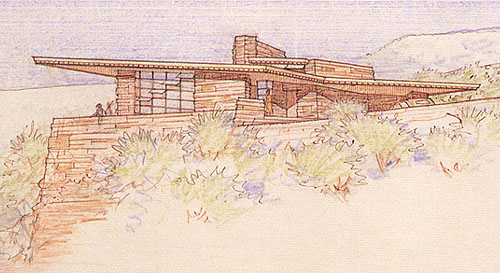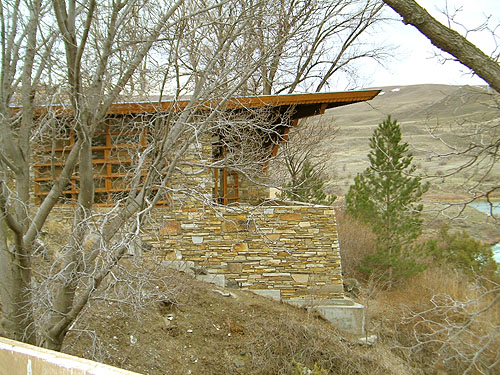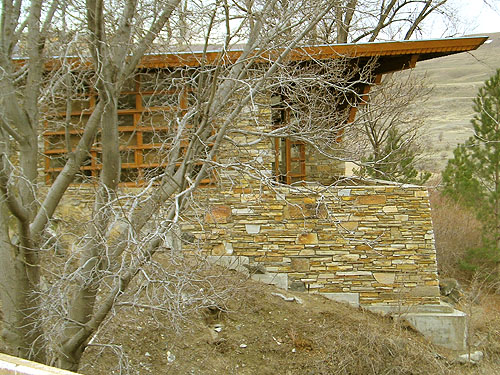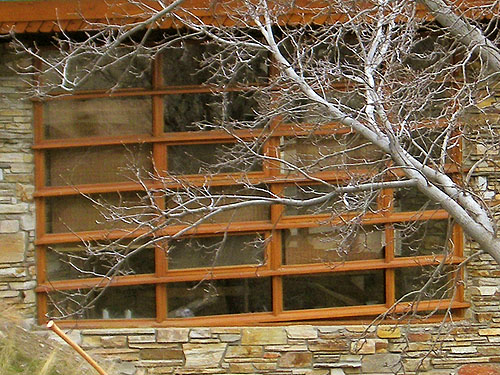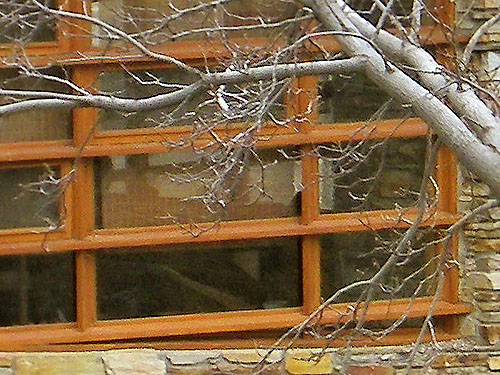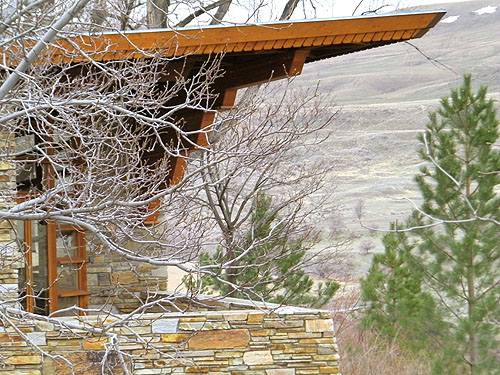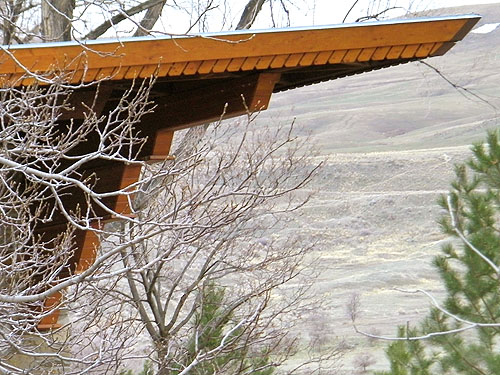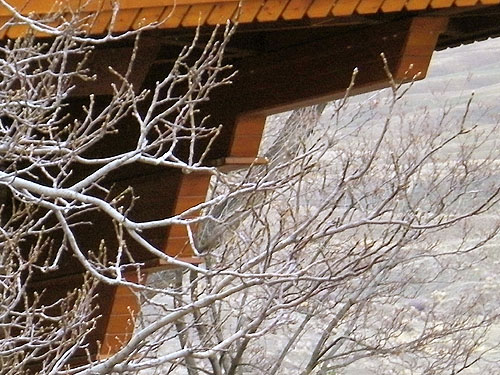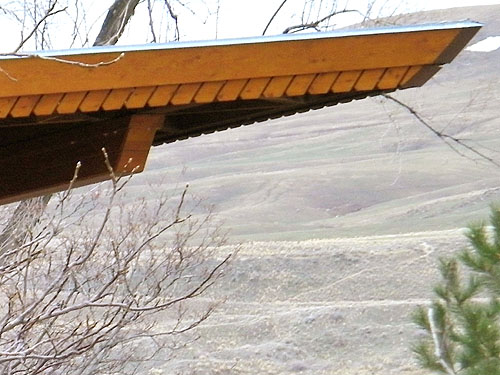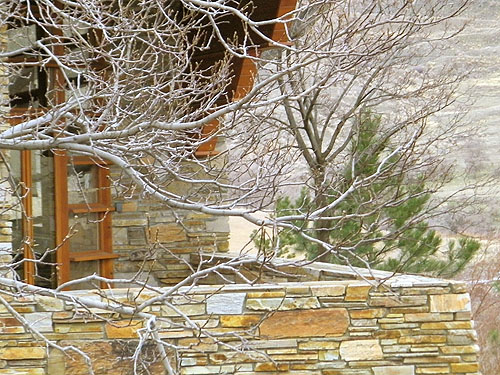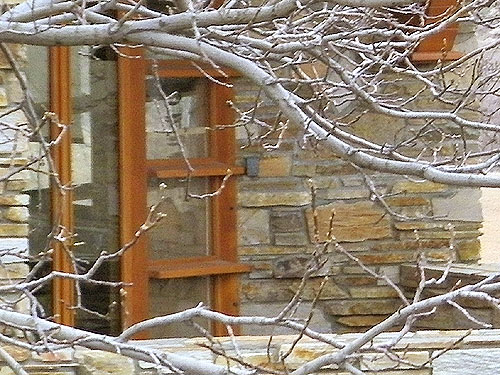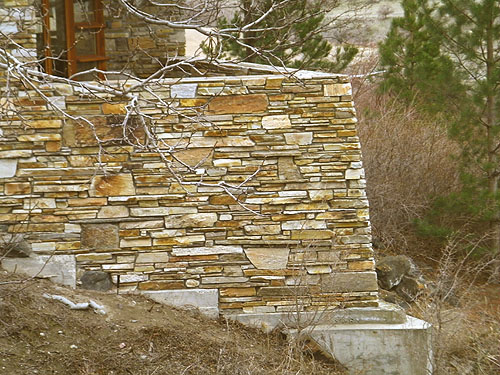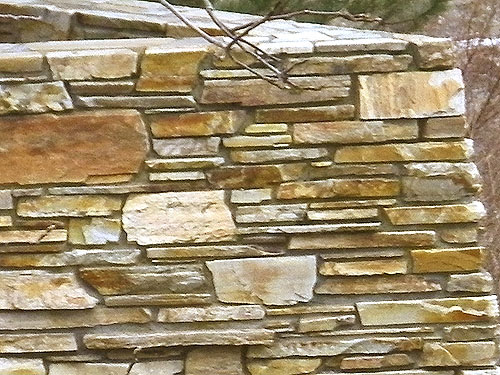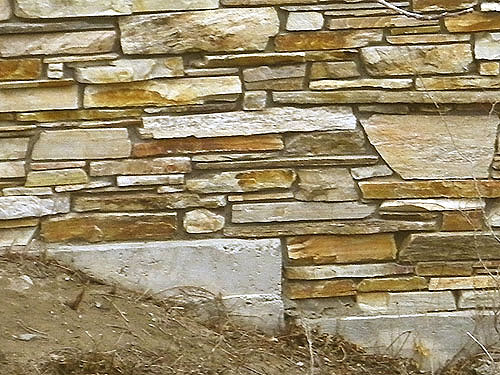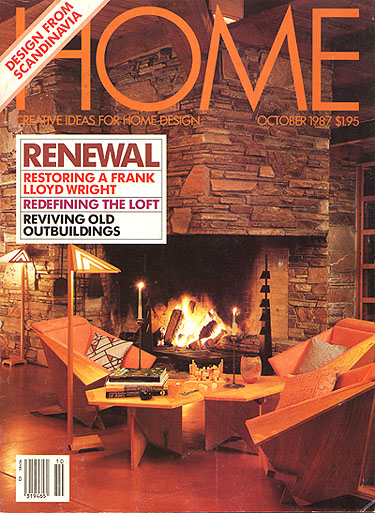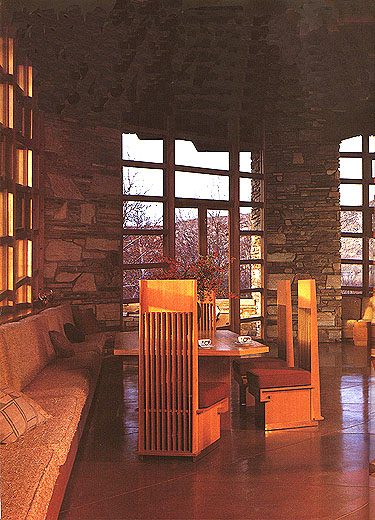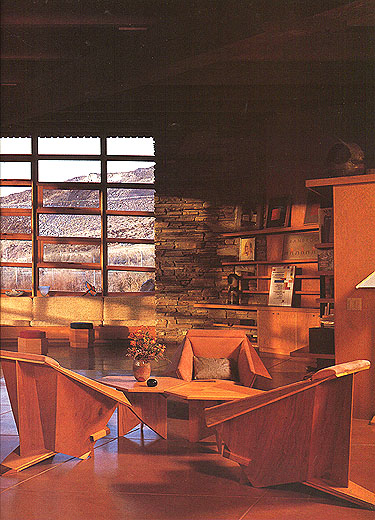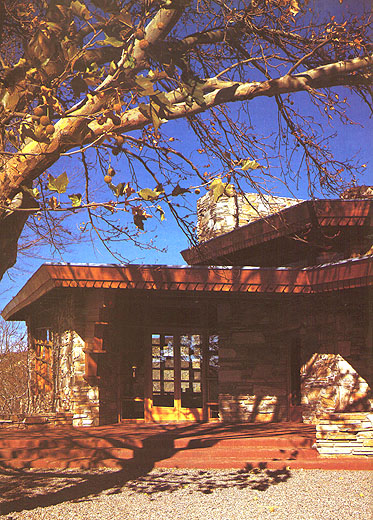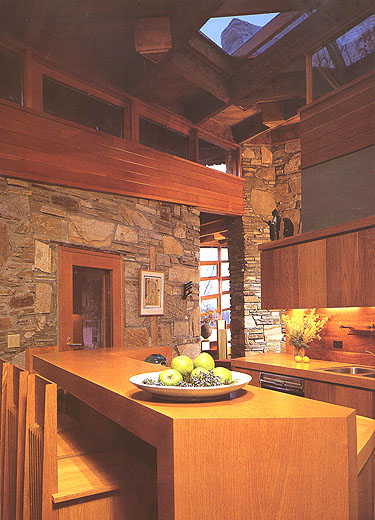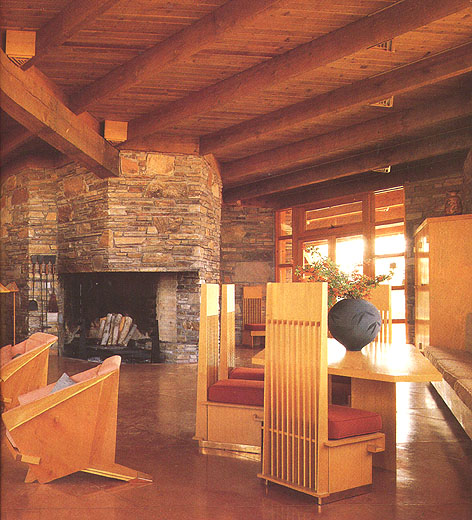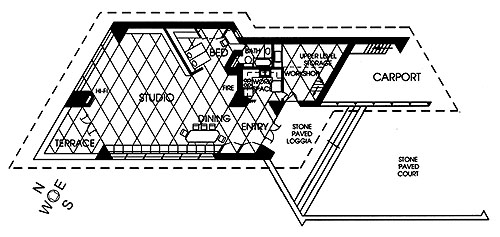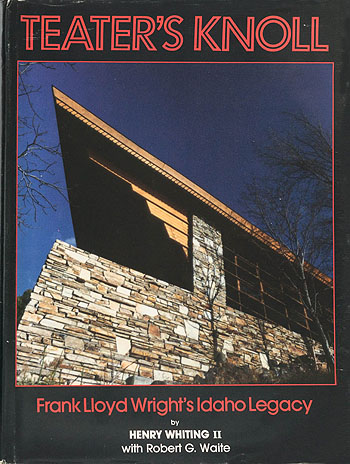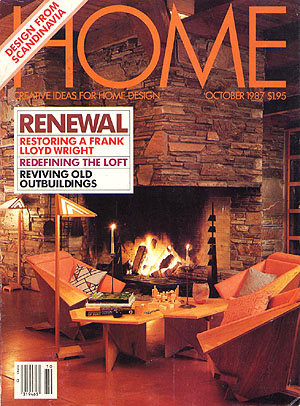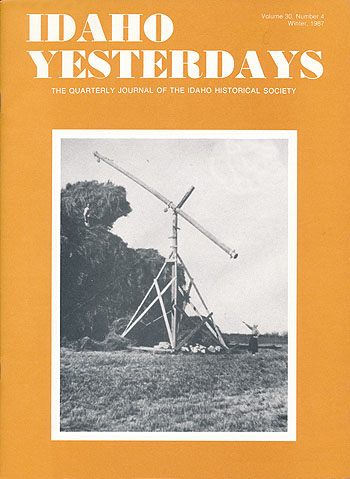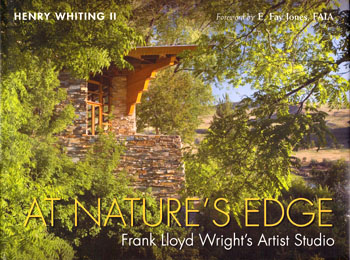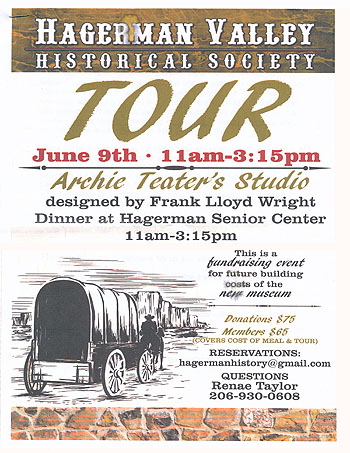
SUPPORT
THE WRIGHT LIBRARYPROCEEDS FROM EVERY SALE GOES TO SUPPORT THE WRIGHT LIBRARY.
CLICK TO ORDER.
Archie Boyd and Patricia Teater Studio-Residence, Bliss, Idaho (1952 - S.352)
On a recent trip from Chicago to Seattle with my daughter, we had a few minutes to stop and see the Teater Residence. It is just a few minutes off the interstate in Bliss, and is Wright’s only work in Idaho. In 1949, the Teaters purchased the two acre parcel on a bluff overlooking the Snake River winding through the valley below. Designed in 1952, construction began in the fall of 1953 and was completed four years later in 1957. Archie Teater was a prolific painter and he and Pat lived in the Studio-Residence in the spring and fall until the mid 1970's when Archie’s health began to fail. He passed away in 1978 and she in 1981. The Studio-Residence sat vacant for a number of years until in 1982 when the present owner, writer Henry Whiting, nephew of a Taliesin apprentice Alden Dow, purchased it after it was put on the market. Tom Casey, an apprentice of Wright’s, supervised the original construction and was also involved in later renovations. There are many classic Wright details. The basic materials consisted of glass, concrete, local wood and stone and follows a diamond grid pattern. Oakley stone, used on the interior and exterior, was quarried from the mountains south of Oakley, Idaho near the Utah border. The Teaters used native oak trim. There are the built-in furnishings as well as triangular light fixtures in the ceiling. Concrete floors, cantilevered roofs, a large expansive room and the centrally located fireplace. I did not have the opportunity to view very much of the home. There is a very tall fence along the road indicating a desire for privacy, and the bluff makes it impossible to view the rest of the home. After returning home and finding a copy of Home Magazine in my library, I came to realize how truly stunning this home is. Henry Whiting has done a remarkable restoring it. For more information the present owner, Henry Whiting has written “At Nature's Edge, Frank Lloyd Wright’s Artist Studio” At Nature’s Edge chronicles the design and history of the studio and the restorations that were necessary to preserve it after years of neglect. The book is vividly illustrated with contemporary color photographs, historical black and white images, and Frank Lloyd Wright’s original drawings. Also by Whiting: Learning the Wright Lessons. 2 ½ years restoring Teater’s Knoll, Home, October 1987 March 2009
Original drawing of the Teater Studio-Residence, viewed from the Southwest. Courtesy of the Frank Lloyd Wright Foundation. Detail from original drawing. Courtesy of the Frank Lloyd Wright Foundation. Exterior Photographs By Douglas Steiner, March 2009
There are many classic Wright details. The basic materials consisted of glass, concrete, local wood and stone and follows a diamond grid pattern. Oakley stone, used on the interior and exterior, was quarried from the mountains south of Oakley, Idaho near the Utah border. The Teaters used native oak trim. There are the built-in furnishings as well as triangular light fixtures in the ceiling. Concrete floors, cantilevered roofs, a large expansive room and the centrally located fireplace.
1: View from the North, the Living Room is on the left, the Balcony is on the right.
2: Closer view from the North, the Living Room is on the left, the Balcony is on the right. Cantilevered roof overhang on the right. 3: Living Room window. 4: Detail of the Living Room window.
5: Detail of the Balcony and cantilevered roof overhang. Early images do not include this decorative roof brace, but show a simple kneebrace. This is consistent with Wright’s original drawings.
6: Cantilevered roof overhang detail. Roof brace is consistent with Wright’s original drawings.
7: Cantilevered roof support detail. Roof brace is consistent with Wright’s original drawings.
8: Cantilevered roof detail.
9: Detail of the Balcony and cantilevered roof overhang.
10: Detail of the Balcony door and window.
11: Detail of the Balcony and foundation.
12: Detail of the Oakley stone masonry.
13: Detail of the Oakley stone masonry and foundation. Text and Photographs by Douglas M. Steiner, Copyright 2009
"Learning the Wright Lessons". Home, October 1987
(Note, Home Magazine is no longer being publishing,
I have copied excerpts of the text, but give all the credits available.)
Home Magazine - October 1987
Published Monthly by Home Magazine Publishing Corp., a subsidiary of Knapp Communications Corp., Los Angeles, CA
"Learning the Wright Lessons. An aficionado of Frank Lloyd Wright recounts the 2 ½ years he spent restoring Teater’s Knoll, The architect’s only Idaho structure." Pp 38-45
By Henry Whiting II, Introduction and captions by Editor Wendy A. Silverstein
Introduction and captions by Editor Wendy A. Silverstein
Text By Henry Whiting II
Photographs by Christopher Irion
Excerpts from Introduction and captions by Editor Wendy A. Silverstein
...Henry Whiting, the second owner of Teater’s Knoll, wanted a space that did more than just satisfy basic cooking and storage needs. Since there was no room to expand the original alcove kitchen, he decided to relocate it into an adjacent workshop area that original owner Archie Teater had used for stretching canvas and mixing paint.
Whiting first broke down the stud wall behind the old kitchen and the artist’s workshop. In redesigning the new kitchen’s cabinets, counters and walls he conformed to Wright’s statical and structural themes, repeating the 60- and 120-degree angles found in the original floor plan. A hexagonal skylight and interior clerestories built into a new wall illuminate the new food preparation area.
Though Wright originally specified cypress for most surfaces in the Teater kitchen, Whiting instead chose maple countertops and white oak cabinets with walnut trim. The barstools he designed for the kitchen counter were inspired by Wright’s dining room chairs.
The remodeled kitchen embodies many of Wright’s design principles. The dining area is still related to the kitchen, and there are considerably more work space and cabinets than before. Counter seating and the newly added below-counter washer and dryer give the kitchen added function. Whiting’s carefully crafted design, enveloped by the original stone walls, is his tribute to Wright.
Cover: In restoring a Frank Lloyd Wright-designed studio in Idaho, Henry Whiting preserved the architecture’s harmony and detail. Strong angularity, here based on the parallelogram, and unity with nature, exemplified by the stone fireplace, are vintage wright. Chairs, Hexagonal Tables and Standing Lamps were built by contractor Jack McNamara, from Frank Lloyd Wright designs. The andirons, grate and tools, were newly designed by former Wright apprentice Tom Casey of Taliesin Associates Architects and made by Mark Sheehan.
Page 38-39: Wright’s dining table and chairs were original to the studio. The window seats were built by contractor Jack McNamara, from Frank Lloyd Wright’s design. The Book shelves and footstools were original. The hexogonal tables and accompanying chairs are recent additions, and were built by contractor Jack McNamara, from Frank Lloyd Wright designs.
Page 40: A stepped bracket detail supports a once-sagging area of the roof.
Page 42: Henry Whiting’s new kitchen is far more spacious and practical than the original. The counter seating give the kitchen added function. The barstools Whiting designed for the kitchen counter were inspired by Wright’s dining room chairs. Note that a wooden post (embedded in the stone wall at center) is all that remains of the stud wall that once separated the original kitchen and workshop. The Kitchen door (fir), Counters (maple) and cabinets (oak with walnut trim) were custom made by Earl Englemann.
Page 45: Mark Sheehan made the andirons, grate and tools, newly designed by former Wright apprentice Tom Casey of Taliesin Associates Architects.
Photographs by Christopher Irion. Excerpts from Introduction and captions by Editor Wendy A. Silverstein. Floor Plan Floor plan copyright 1993, “The Frank Lloyd Wright Companion” Storrer, William Allin, page 374-375.
Date: 1987
Title: Teater’s Knoll: Frank Lloyd Wright’s Idaho Legacy (Hard Cover DJ) (Published by Northwood Institute Press, Midland, Michigan)
Author: Whiting, Henry II; Waite, Robert G.
Description: Dust jacket: "Teater’s Knoll: Frank Lloyd Wright’s Idaho Legacy is an unusual book in the sense that it is a biography of a building. It tells the story of the life cycle of the Archie Teater Studio, which is treated throughout the book as a living object. It's birth, life, decline, and rebirth are thoroughly chronicled in these pages. Additional characters include Frank Lloyd Wright, the Teater Studio’s architect, who was enjoying the busiest and most notorious period of his long career. Archie Teater was just beginning to gain a reputation as a landscape painter in Jackson hole, Wyoming..." (First Edition)
Size: 9.25 x 12.25
Pages: Pp 188
ST#: 1987.133.1021Date: 1987 Title: Home - October 1987 (Published by Home Magazine Publishing Corp.)
Author: Anonymous Author: Whiting, Henry II Author: Silverstein, Wendy A. Description: "Go Wright In." A list of six public Wright sites that are open to the public. Original List Price $1.95. (See Wright Study) Description: "Learning the Wright Lessons. An aficionado of Frank Lloyd Wright recounts the 2 ½ years he spent restoring Teater’s Knoll, the architects only Idaho structure." Includes 14 photographs and one illustration. Original List Price $1.95. (See Wright Study) Description: "Rethinking the Kitchen." Original List Price $1.95. (See Wright Study) Size: 8 x 10.75 Size: 8 x 10.75 Size: 8 x 10.75 Pages: Pp 17 Pages: Pp Cover, 2, 38-45 Pages: Pp 43 ST#: 1987.19.0305 ST#: 1987.20.0305 ST#: 1987.21.0305
Date: 1987
Title: Idaho Yesterday - Winter 1987 (Published four times a year by the Idaho State Historical Society, Boise, Idaho)
Author: Waite, Robert G.
Description: "A Spot of Interest to Humanity. Hagerman's Archie Theater Studio, Frank Lloyd Wright, Architect. While Frank Lloyd Wright is well known as an architect, the one structure he designed in Idaho is not at all well known. The story of its construction is an intriguing one, told here by a professional historian who was also one of the work crew that spent two and a half years restoring the house. All photographs but those on pages 19 and 24 are kindly provided by the owner of the house, Henry Whiting. He and Robert Waite have collaborated on a book about the house that will be published this year. The author, who formerly taught at Idaho State and Boise State university's, presently lives in Washington, D. C..." Includes 13 photographs. Original cover price $15.00 per year.
Size: 7.75 x 10.5
Pages: Pp 18-30
ST#: 1987.108.0519Date: 2007 Title: At Nature’s Edge. Frank Lloyd Wright’s Artist Studio (Published by The University of Utah Press, Salt Lake City)
Author: Whiting, Henry II; Foreword by Jones, E. Fay
Description: The Archie and Patricia Teater Home and Studio (S.352 1952). Perched high on a cliff above the Snake River in a remote area of Idaho, Frank Lloyd Wright’s artist studio is a testament to the architect’s total mastery of his craft. The simple, one-room studio Wright designed for Idaho landscape painter Archie Boyd Teater and Patricia Teater in 1952 is a sophisticated, complex work of art. As Wright’s only artist studio (other than his own), the structure was intended to foster the creative life. Located on one of the most spectacular natural sites Wright ever worked with, the studio at Teater’s Knoll is a premier example of organic architecture at its best, where the fundamental integration with nature blurs the meeting of building and nature. At Nature’s Edge chronicles the design and history of the studio and the restorations that were necessary to preserve it after years of neglect. (Publisher’s description.) Original list price $39.95. (First Edition)
Size: 12.5 x 9.25
Pages: Pp 125
ST#: 2007.60.0511
Date: 2018
Title: Archie Teater Studio, Bliss, Idaho (1952 - S352).
Description: Flyer for 2018 Archie Teater Studio Tour. "The Hagerman Valley Historical Society. Tour. June 9. 11 am - 3:15 pm. Archie Teater’s Studio designed by Frank Lloyd Wright. Dinner at Hagerman Senior Center."
Size: 8.5 x 11.
Pages: Two pages.
ST#: 2018.40.1021
Related Books
"Teater's Knoll Frank Lloyd Wright's Idaho Legacy", Whiting, Waite, 1987 "Frank Lloyd Wright Monograph 1951-1959", Text: Pfeiffer, Bruce Brooks;
Edited and Photographed: Futagawa, Yukio, 1988, page 34-37.“The Frank Lloyd Wright Companion”, Storrer, William Allin, 1993, page 374-375. "Frank Lloyd Wright and the Meaning of Material" Patterson, 1994, page 31. "The Vision of Frank Lloyd Wright" Heinz, 2000, page 248-249. "Frank Lloyd Wright: The Western Work", Legler, Dixie, 1999, page 70-71. “At Nature's Edge, Frank Lloyd Wright’s Artist Studio” Whiting, 2007, pp 175 "Frank Lloyd Wright, Complete Works 1943-1959", Pfeiffer; Gossel, 2009, pages 324-325.
Related Images and Articles
- (Note, due to the fact that the internet is constantly changing, and items that
are posted change, I have copied the text, but give all the credits available.)A) Learning the Wright Lessons. 2 ½ years restoring Teater’s Knoll, Whiting, Henry II, Home, October 1987 B) Archie Teater's Studio, By Joe Siebel, September 1991 (PDF). C) Teater's Knoll, Bliss, By Sara Beitia, August 2, 2006 D) Archie Boyd Teater Biography E) The Tale of Teton Teater, By Cara Froedge, Summer 2008 F) The Archie B. Teater Collection

